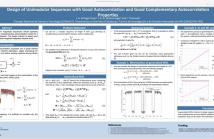
The fifth IEEE Global Conference on Signal and Information Processing (GlobalSIP) will be held in Montreal, Quebec, Canada on November 14-16, 2017. GlobalSIP is a flagship IEEE Signal Processing Society conference. It focuses on signal and information processing with an emphasis on up-and-coming signal processing themes. The conference features world-class plenary speeches, distinguished Symposium talks, tutorials, exhibits, oral and poster sessions, and panels. Visit website.
- Read more about ON THE CONVERGENCE OF CONSTRAINED PARTICLE FILTERS
- Log in to post comments
The power of particle filters in tracking the state of non-linear and non-Gaussian systems stems not only from their simple numerical implementation but also from their optimality and convergence properties. In particle filtering, the posterior distribution of the state is approximated by a discrete mass of samples, called particles, that stochastically evolve in time according to the dynamics of the model and the observations. Particle filters have been shown to converge almost surely toward the optimal filter as the number of particles increases.
- Categories:
 28 Views
28 Views
- Read more about Design of unimodular sequences with good autocorrelation and good complementary autocorrelation properties
- Log in to post comments
Complex sequences with constant magnitude in the time domain and good aperiodic autocorrelation properties are of fundamental interest due to its applications. Their design typically involves the minimization of a nonlinear function that strives to make equal to zero the correlation coefficients in a region of interest. In this letter, the design of unimodular sequences whose aperiodic autocorrelation and aperiodic complementary autocorrelation vanish for a given set of lags is proposed.
- Categories:
 32 Views
32 Views
- Read more about Design of unimodular sequences with good autocorrelation and good complementary autocorrelation properties
- Log in to post comments
Complex sequences with constant magnitude in the time domain and good aperiodic autocorrelation properties are of fundamental interest due to its applications. Their design typically involves the minimization of a nonlinear function that strives to make equal to zero the correlation coefficients in a region of interest. In this letter, the design of unimodular sequences whose aperiodic autocorrelation and aperiodic complementary autocorrelation vanish for a given set of lags is proposed.
- Categories:
 7 Views
7 Views- Read more about Fast Fractional-Pixel Motion Estimation using Lagrangian-Based Error Surface Interpolation
- Log in to post comments
Motion Estimation is an important module in the HEVC encoder.
It is divided into Integer-pixel Motion Estimation followed
by Fractional-pixel motion Estimation for coding efficiency
improvement. In this paper, a new algorithm is proposed
to estimate the best fractional-pixel motion vector. It
is based on a mathematical model using the matching error
costs of the integer pixel locations around the best integer
candidate. The proposed algorithm is implemented in HEVC
standard software (HM-16.9). The experimental results show
- Categories:
 18 Views
18 Views- Read more about Design of unimodular sequences with good autocorrelation and good complementary autocorrelation properties
- Log in to post comments
Complex sequences with constant magnitude in the time domain and good aperiodic autocorrelation properties are of fundamental interest due to its applications. Their design typically involves the minimization of a nonlinear function that strives to make equal to zero the correlation coefficients in a region of interest. In this letter, the design of unimodular sequences whose aperiodic autocorrelation and aperiodic complementary autocorrelation vanish for a given set of lags is proposed.
- Categories:
 10 Views
10 Views- Read more about GlobalSip_2017
- Log in to post comments
Consider a social network where only a few nodes (agents)
have meaningful interactions in the sense that the conditional
dependency graph over node attribute variables (behaviors)
is sparse. A company that can only observe the interactions
between its own customers will generally not be able to ac-
curately estimate its customers’ dependency subgraph: it is
blinded to any external interactions of its customers and this
blindness creates false edges in its subgraph. In this paper
we address the semiblind scenario where the company has
- Categories:
 3 Views
3 ViewsThe QR (Quick Response) code is a two-dimensional barcode, which was designed for storage information and high speed reading applications. Being cheap to produce and fast to read, it becomes actually a popular solution for product labeling.
Ones try to make QR code a solution against counterfeiting. We present a novel technique that permits to create a secure printed QR code which is robust
- Categories:
 280 Views
280 Views- Read more about Phase Retrieval Based Deconvolution Algorithm in Optical Systems
- Log in to post comments
In an optical imaging system, the retrieved image of an object is blurred by the point spread function (PSF) of the system,and cannot exactly represent the object. Deconvolution is an effective method to recover the object from the blurred image and improve the resolution of the optical system. But in real optical system, the detector only measures the intensity of the light, not the phase.
- Categories:
 23 Views
23 Views- Read more about COMPRESSIVE ONLINE ROBUST PRINCIPAL COMPONENT ANALYSIS WITH MULTIPLE PRIOR INFORMATION
- Log in to post comments
- Categories:
 9 Views
9 Views